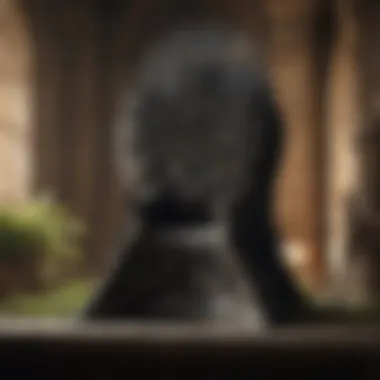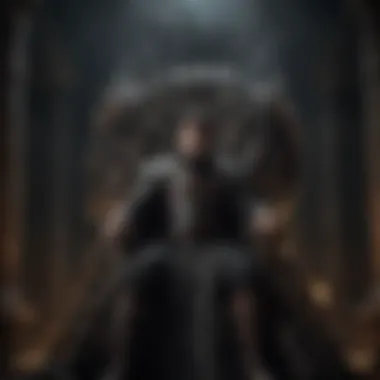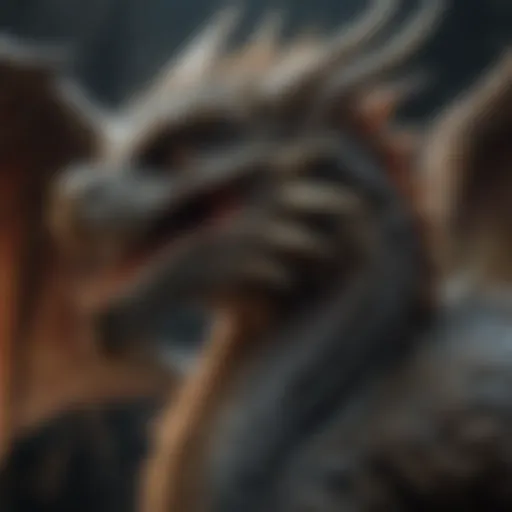Unraveling the Enigmatic Iron Throne: A Game of Thrones Exploration


Character Dissections
As we embark on unraveling the intricate details of the Iron Throne in Game of Thrones, it is imperative to dissect the key characters who have played pivotal roles in the narrative tapestry. Characters such as Jon Snow, Daenerys Targaryen, and Cersei Lannister will undergo meticulous analysis to unveil their motivations, complexities, and evolution over the course of the series. Each character's journey will be scrutinized to understand their impact on the overarching storyline and their relationships with the coveted seat of power.
Lore Explorations
In this quest to decipher the enigmatic Iron Throne, we delve into the rich tapestry of history and lore that binds the fictional realm of Westeros. By exploring the ancient legends, historical conflicts, and cultural nuances of this world, we uncover hidden details and connections that shed light on the significance of this iconic symbol of power. From the practices of the Old Gods to the traditions of the Targaryen dynasty, every facet of Westerosi lore contributes to the profound mystique surrounding the Iron Throne.
Episode Breakdowns
To illuminate the complexities of the Iron Throne, we meticulously recap significant events from each episode of Game of Thrones. Through a detailed examination of themes, symbolism, and character interactions, we unravel the layers of intrigue and power dynamics that shape the narrative landscape. Key moments such as the Red Wedding, the Battle of the Bastards, and the Long Night will be deconstructed to elucidate their implications on the broader Game of Thrones saga.
Fan Theories
As we navigate the realm of fan speculation and conjecture, we compile a compendium of popular and thought-provoking fan theories surrounding the Iron Throne. By evaluating these theories against evidence from the show and leveraging our insights into character behaviors and narrative patterns, we engage in a rigorous analysis of their validity and potential impact on future plot developments. From prophecies of Azor Ahai to the true lineage of certain characters, the realm of fan theories offers a tantalizing glimpse into the unpredictable twists and turns that may shape the ultimate fate of the Iron Throne.
Intro
In the vast landscape of cultural phenomena, Game of Thrones stands as a monolith of modern television. Its intricate narrative weaves tales of power, betrayal, and honor, captivating audiences worldwide. At the heart of this epic saga lies the Iron Throne, an iconic symbol of authority and ambition. This article aims to dissect the layers of complexity surrounding this coveted seat of power, shedding light on its historical significance and the power struggles it embodies.
Overview of Game of Thrones
Game of Thrones, created by George R. R. Martin, transcends traditional storytelling with its ruthless portrayal of power dynamics. Set in the fictional continents of Westeros and Essos, the series chronicles the myriad houses vying for control in a brutal game of thrones. Each character adds a unique flavor to the narrative, deepening the political intrigue and strategic alliances that shape the fate of the Seven Kingdoms.
Significance of the Iron Throne
Symbol of Power
The Iron Throne stands as a towering emblem of authority, forged from the fires of dragon flames and bloodshed. Its jagged swords symbolize the conquests and sacrifices that underpin the ruling regime. This symbol of power exudes a magnetic allure, drawing ambitious souls seeking to grasp the reins of destiny. Despite its grandeur, the throne carries a heavy burden of responsibility, dictating the fates of rulers and subjects alike.
Historical Origins
The genesis of the Iron Throne dates back to Aegon the Conqueror's conquest of Westeros. Crafted from the swords of his defeated enemies, the throne encapsulates centuries of warfare and political upheaval. Its historical origins intertwine with the turbulent past of the Seven Kingdoms, reflecting a legacy stained with bloodshed and whispers of betrayal. Legends shroud the forging of the throne, infusing it with an aura of mystery and dread.


Political Intrigues
Within the shadowed corridors of King's Landing, political machinations dictate the fate of kingdoms. Betrayals lurk behind every smile, and alliances are fragile as spun glass. The Iron Throne breeds a culture of deception and manipulation, where loyalty is a scarce commodity. Strategies for claiming the throne range from subtle diplomacy to outright warfare, with each move echoing across the realm. The tangled web of political intrigues casts a web of uncertainty over the rulers, ensuring that every decision carries dire consequences.
Symbolism and Power Dynamics
In the complex tapestry of Game of Thrones, the theme of Symbolism and Power Dynamics plays a pivotal role, serving as the bedrock upon which the intricate plotlines unfold. Symbolism permeates every facet of the narrative, from the physical representation of power in the majestic Iron Throne to the subtle gestures and alliances that speak volumes about hierarchical structures. Power Dynamics intricately woven into the storyline showcase the constant struggle for supremacy, where strategies are devised, alliances forged, and betrayals executed in a relentless pursuit of power. Understanding the Symbolism and Power Dynamics is crucial to unraveling the depths of Game of Thrones and appreciating the complexities of the characters' motivations and actions.
Implications of Sitting on the Iron Throne
Ambition and Conquest
Ambition and Conquest, two driving forces in the ruthless pursuit of power within Game of Thrones, embody the relentless nature of ambition and the conquest it demands. Ambition fuels characters to ascend the perilous ladder of power, driving them to make choices that can lead to glory or downfall. Conquest, with its allure of dominance and control, becomes a path fraught with peril as characters navigate treacherous waters to claim their seat on the Iron Throne. The unique feature of Ambition and Conquest lies in their ability to showcase the lengths individuals are willing to go to achieve their desires, blurring the lines between heroism and villainy, creating a dynamic landscape filled with ambition's echoes.
Moral Corruption
Moral Corruption, a shadow that looms over the Iron Throne, taints even the noblest of intentions with its insidious influence. The key characteristic of Moral Corruption lies in its seductive nature, often leading characters astray as they grapple with the temptations that power presents. This aspect adds a layer of moral complexity to the narrative, unraveling the inner struggles of characters who must balance their principles with the harsh realities of a world where power corrupts absolutely. Moral Corruption's advantage lies in its ability to showcase the fragility of virtue, creating compelling arcs that challenge traditional notions of heroism and villainy within the context of the Iron Throne's all-consuming power.
Quest for Legitimacy
The Quest for Legitimacy stands as a noble pursuit in a sea of deceit and betrayal, offering characters a chance to secure their place in history through rightful means. The Quest for Legitimacy becomes a beacon of hope for those who seek to rule with honor and legitimacy, a stark contrast to the cutthroat tactics employed by their rivals. The unique feature of this quest lies in its ability to showcase the resilience of characters who uphold principles in the face of overwhelming odds, drawing a poignant narrative of honor amidst the chaos of ambition and power struggles. The Quest for Legitimacy's advantages include fostering admiration for characters who choose the path less traveled, championing ideals in a world where betrayals reign supreme.
Political Maneuvering
Alliances and Betrayals
Within the intricate web of Game of Thrones, Alliances and Betrayals stand as pillars of influence, shaping the destiny of kingdoms and characters alike. The key characteristic of Alliances and Betrayals lies in their volatile nature, where allegiances forged one day can crumble the next under the weight of ambition and self-preservation. Alliances offer characters strength in unity, yet they also expose vulnerabilities that can be exploited by those adept at the game of thrones. Betrayals, on the other hand, serve as cautionary tales, reminding players of the high stakes involved in a world where trust is a rare commodity. The advantage of Alliances and Betrayals is their ability to add layers of complexity to characters' relationships, creating a tapestry of alliances woven with threads of treachery.
Strategies for Claiming the Throne
Strategies for Claiming the Throne emerge as calculated maneuvers that test characters' wit and resolve in the relentless pursuit of power. The key characteristic of these strategies lies in their adaptability, where characters must constantly evolve their tactics to outsmart rivals and secure their claim. Strategies become the lifeblood of ambition, offering a roadmap to power that demands cunning, resourcefulness, and sometimes sacrifice. The advantage of employing strategies lies in their ability to tilt the scales of power in favor of those who possess the foresight to anticipate their rivals' moves and outmaneuver them in the deadly game of thrones.
Role of Deception


The Role of Deception casts a long shadow over the machinations of power within Game of Thrones, where truth becomes a rare commodity in the face of deception's seductive allure. The key characteristic of Deception lies in its dual nature, where lies can be wielded as swords or shields, depending on the wielder's intent. Deception becomes a potent weapon in characters' arsenals, a tool used to cloak agendas, manipulate adversaries, and secure strategic advantages in the high-stakes game of thrones. The advantage of embracing deception lies in its ability to keep adversaries off balance, concealed in a labyrinth of half-truths and misdirection that tilts the odds in favor of those who master its intricate dance of shadows.
Historical Context and Evolution
The segment focusing on the Historical Context and Evolution within the context of the Iron Throne in Game of Thrones occupies a pivotal role in unraveling the layers of intrigue and power dynamics encapsulated by this iconic symbol. Delving into the roots and transformations of the Iron Throne provides a profound understanding of its symbolic weight and the intricate web of history woven around it. By chronicling the evolution of this formidable seat, readers are offered a glimpse into the past rulers, conquests, and political machinations that have shaped the narrative fabric of the series, elevating the significance of each twist and turn in the quest for power. An exploration of the Historical Context and Evolution not only adds depth to the overall discourse but also serves as a anchor for comprehending the present-day struggles and ambitions in the Game of Thrones universe.
Creation of the Iron Throne
Aegon's Conquest
The recounting of Aegon's Conquest stands as a defining moment in the establishment of the Iron Throne's legacy. Aegon's audacious campaign to unify the Seven Kingdoms under his rule mirrors the inherent themes of conquest, subjugation, and consolidation embedded within the narrative of Game of Thrones. The strategic brilliance exhibited during Aegon's Conquest and the subsequent forging of the Iron Throne solidified his authority and set the tone for the power struggles that followed. By shedding light on this seminal event, readers gain insight into the ruthless ambition and visionary foresight that defined Aegon's reign, shaping the course of history and the Iron Throne's enduring allure.
Forging of the Throne
The process of Forging the Throne holds a symbolic weight that reverberates through the annals of Westeros. The craftsmanship, symbolism, and sheer artistry involved in creating the Iron Throne serve as a testament to the lengths individuals would traverse to secure and exhibit power. The physical manifestation of this endeavor, with each sword melted and molded into a seat of authority, reflects the sacrifice, ambition, and inherent brutality infused within the Game of Thrones realm. The Forging of the Throne not only embodies the tangible construction of power but also signifies the sacrifices and compromises demanded by rulers vying for dominance, establishing a legacy that transcends mere materiality.
Transformations Over Time
Influential Rulers
Exploring the impact of Influential Rulers on the evolution of the Iron Throne illuminates the shifts in power, ideology, and governance that have shaped its journey. From ruthless tyrants to noble monarchs, each ruler's imprint on the Throne echoes through generations, leaving a mark on the political landscape of Westeros. Understanding the strategies, personalities, and legacies of these influential figures offers a nuanced perspective on the contest for kingship and the intricacies of leadership within the Game of Thrones narrative. By dissecting the reigns of these pivotal monarchs, readers are immersed in a tapestry of triumphs, tragedies, and transformative decisions that underscore the raw essence of power.
Adaptations and Modifications
The concept of Adaptations and Modifications manifests as a testament to the ever-evolving nature of the Iron Throne and its surrounding power structures. As rulers ascended and dynasties fell, the Throne witnessed adaptations, alterations, and embellishments that mirrored the shifting tides of politics and warfare in Westeros. The modifications made to the Throne, whether for ceremonial purposes, strategic advantages, or symbolic gestures, reflect the fluidity and precariousness of power within the Game of Thrones realm. By scrutinizing these adaptations, readers gain insight into the malleability and fragility of authority, accentuating the perpetual struggle for dominance and survival in a realm where allegiances are fleeting and betrayal lurks at every corner.
Cultural Impact and Legacy
In this section, we delve into the far-reaching influence that the cultural impact and legacy of the Iron Throne in Game of Thrones have had. The essence of this discussion lies in understanding how this iconic element transcends mere visual representation to become a symbol deeply embedded in popular culture. The allure and fascination surrounding the Iron Throne extend beyond its presence on-screen, resonating with audiences globally. Its legacy is not just confined to the realm of entertainment but has seeped into various facets of society and discourse.
Fans have deconstructed the symbolism of the Iron Throne, fueling discussions on power dynamics, ambition, and the consequences of relentless pursuit. Viewers often find parallels between the struggles for power in the show and real-world scenarios, reflecting on themes of authority and governance. The cultural impact of the Iron Throne goes beyond the confines of television, sparking debates on leadership, ethics, and the corrupting nature of power. Its legacy endures, even after the show's conclusion, leaving a lasting impression on audiences worldwide.
Popularity and Fan Interpretations


Fan Theories
Exploring fan theories surrounding the Iron Throne adds a layer of intrigue and speculation to the narrative. Fans engage in detailed analyses, proposing alternative endings, character motivations, and hidden meanings within the storyline. The allure of fan theories lies in their ability to provide fresh perspectives and interpretations, breathing new life into the series long after its airing. Delving into these theories allows for a deeper exploration of the show's nuances, inviting fans to participate actively in uncovering hidden truths.
Fan theories contribute significantly to the longevity of a series, keeping interest alive between seasons and after the finale. They encourage critical thinking, creativity, and imagination among viewers, fostering a dynamic community of enthusiasts eager to unravel the show's mysteries. While some theories may veer into the realm of speculation, they add an enriching dimension to the viewing experience, showcasing the passionate engagement of the fan base.
Symbolic Interpretations
The symbolic interpretations surrounding the Iron Throne offer a glimpse into the allegorical significance of this iconic emblem. Viewers analyze the throne as a metaphor for the burdens of leadership, the cost of ambition, and the cyclical nature of power struggles. Symbolic interpretations deepen the viewer's appreciation of the narrative, inviting reflection on broader themes such as fate, morality, and the transient nature of authority.
By examining the symbolic underpinnings of the Iron Throne, fans unearth hidden layers of meaning embedded in its design and history. Through these interpretations, audiences gain a deeper understanding of the characters' motivations, the consequences of their actions, and the evolving dynamics of power throughout the series. Symbolic analyses elevate the viewing experience, transforming a fictional seat of power into a profound symbol of human nature and societal complexity.
Influence Beyond the Show
Political Analogies
Drawing parallels between the political landscape in Game of Thrones and real-world scenarios offers valuable insights into governance, diplomacy, and power dynamics. Political analogies explore the complexities of leadership, decision-making, and the consequences of unchecked authority. By comparing the events in the show to historical or contemporary political movements, viewers gain a nuanced perspective on the multifaceted nature of conflict and diplomacy.
Political analogies stimulate critical thinking and discussion, prompting audiences to reflect on the repercussions of political decisions and the ethics of power. They highlight the intricate balance between strategy and morality, echoing timeless debates on leadership and governance. Through these analogies, the show transcends its fictional setting, serving as a mirror to the intricacies of real-world politics.
Historical Parallels
Examining historical parallels within Game of Thrones unveils a tapestry of references to past events, figures, and conflicts. The series draws inspiration from various historical periods, weaving elements of medieval history, warfare, and diplomacy into its narrative fabric. By recognizing these parallels, viewers explore a rich tapestry of historical allusions that enhance their understanding of the show's thematic depth and narrative intricacies.
Historical parallels connect the fictional realm of Westeros to real-world histories, inviting audiences to draw comparisons between legendary figures and historical rulers. Through these reflections, viewers gain a deeper appreciation for the intricate storytelling techniques employed by the creators, blending elements of fantasy with echoes of reality. Historical insights enrich the viewing experience, providing a contextual framework that resonates with audiences across cultures and epochs.
Culmination
Legacy of the Iron Throne
Within the intricate tapestry of , one uncovers a labyrinth of historical significance and symbolic resonance that embodies the very soul of Game of Thrones. From the veiled shadows of mythical conquests to the unsettling reverberations that posthumously haunt the chambers of kings long gone, the emerges as a living chronicle etched upon the annals of time. It encapsulates the enigmatic ethos of power and the immutable legacy crafted by those who dared to ascend the precarious steps leading to this coveted seat of dominion.
Final Thoughts
Lasting Impression
Nestled within the cradle of scrutiny lies the subtle yet profound essence of , a facet that etches itself indelibly within the recesses of perception. It sparks contemplation, ignites discourse, and shrouds the corridors of memory with narratives that linger as whispers in the winds of reminiscence. The canvas of offers a portraiture of resolute permanence, weaving nostalgia with contemplation in a delicate dance of eternal essence. Its unique proposition lies in its ability to transcend the boundaries of temporal constraints, etching a mark that defies the eroding sands of time.
Continued Reverberations
Amidst the symphony of echoes resonating in the aftermath, takes center stage, heralding the profound impact that reverberates far beyond the final curtain call. Its resonance extends across the annals of discourse, setting aflame the embers of contemplation and provoking introspection on the cyclical nature of power, legacy, and the eternal dance of consequences. Positioned as the harbinger of subsequent narratives, its intrinsic allure lies in its capacity to sow the seeds of anticipation, heralding the dawn of new beginnings even as the final notes of closure reverberate across the kingdoms.



